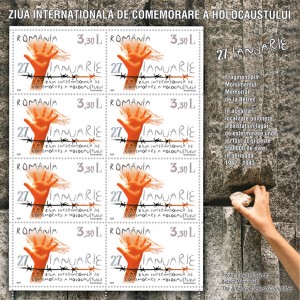 On the 1st of November 2005, the General Assembly of the United Nations Organization enacted a resolution by which the 27th of January has become the International Holocaust Remembrance Day. On the 27th of January 1945, the Allies set free the Auschwitz camp, where three million persons had been gassed (90% of them being Jews). of January 1945, the Allies set free the Auschwitz camp, where three million persons had been gassed (90% of them being Jews). On the 1st of November 2005, the General Assembly of the United Nations Organization enacted a resolution by which the 27th of January has become the International Holocaust Remembrance Day. On the 27th of January 1945, the Allies set free the Auschwitz camp, where three million persons had been gassed (90% of them being Jews). of January 1945, the Allies set free the Auschwitz camp, where three million persons had been gassed (90% of them being Jews).
On the 1st of November 2005, the General Assembly of the United Nations Organization enacted a resolution by which the 27th of January has become the International Holocaust Remembrance Day. On the 27th of January 1945, the Allies set free the Auschwitz camp, where three million persons had been gassed (90% of them being Jews). of January 1945, the Allies set free the Auschwitz camp, where three million persons had been gassed (90% of them being Jews). On the 1st of November 2005, the General Assembly of the United Nations Organization enacted a resolution by which the 27th of January has become the International Holocaust Remembrance Day. On the 27th of January 1945, the Allies set free the Auschwitz camp, where three million persons had been gassed (90% of them being Jews). of January 1945, the Allies set free the Auschwitz camp, where three million persons had been gassed (90% of them being Jews).
On this day, all those who suffered and died during the Holocaust are remembered, in order to give to the current and future generations the lesson of genocide, so that this black page of history may never repeat again.
To mark this day, Romfilatelia, the specialized company in editing and trading postage stamps, introduces into circulation the philatelic issue INTERNATIONAL HOLOCAUST REMEMBRANCE DAY.
Holocaust means the programmed destruction of the Jews of Europe by the Nazi Germany and its allies, during the World War II (1939 – 1945). In the Jewish culture, Jews define the Holocaust by the word of Shoah (the Jewish word meaning “catastrophe” or “total destruction”). Etymologically, the word holocaust reunites the Greek holo (whole) and caustos (burnt), referring, at its origin, an offering in flames or a religious sacrifice entirely consumed by flames. The Holocaust was one of the most terrifying acts of genocide in the history. Those who committed it methodically created the means to gather and kill millions of people. The Holocaust determined the elaboration of the international laws against the violation of the human rights.
At the end of the World War II, in 1945, a large part of the profane and religious culture of the Jews of Europe had been destroyed and almost 6 millions of Jews had been exterminated. Among these, approximately 1.5 millions were children. After the war, the Allies created in Nürnberg, Germany, an International Military Tribunal to judge the Nazi leaders who were guilty of war crimes and of crimes against the humanity. In other important trials of war crimes, which took place in 1945 and 1946, 22 outstanding leaders of the Nazi Germany were found guilty and 12 of them were convicted to death. In Romania, after 1945, several trials took place, in which those who were responsible for committing the Holocaust against the Jews in Romania, Basarabia, Bucovina and Transnistria were judged and convicted.
Later, in 1948, a resolution of the United Nations established that any crime against the humanity should be subject to the international laws, without the possibility of prescription of the prosecution of those accused of such actions. Based on this resolution, France convicted a number of former Nazis, and the United States of America revoked the citizenship of some Nazi collaborators who had immigrated to this country.
Monuments and museums dedicated to the Holocaust were built all over the world. In Germany and the European countries that had been under Nazi occupation, the remains of many camps and execution centres became museums and eloquent proofs of the committed atrocities. In the countries that were not involved in the Holocaust events, the governments and organizations of the survivors also built monuments and museums. Among these organizations counts Yad Vashem, the Authority for the Remembrance of Martyrs and Heroes of the Holocaust, which was founded in 1953, in Jerusalem, based on an act of the Israeli Parliament, in order to glorify the memory of the Jews killed by the Nazis. In the United States of America, two museums were inaugurated in 1993: The Holocaust Memorial Museum, in Washington, which aims at presenting the history of the Holocaust, and the Museum of Tolerance, in Los Angeles, California, which is dedicated to the fight against preconceptions, intolerance, violation of the human rights and crimes against the humanity.
The Holocaust remains a deep wound not only for those who actually lived it, but also for the entire humanity.
In order to prevent history from repeating such atrocious tragedies, we must always remember the horrors of the Holocaust.
The achievement of the postage stamps issue was based on the documentary material through the good will of the National Institute for the Study of the Holocaust from Romania “Elie Wiesel” and of the American Jewish Committee, the editor of the Belzec Memorial Museum Album, whom we thank for giving us the permission to reproduce the picture achieved by Edward Serotta.
Issue date: 2007-01-27
















